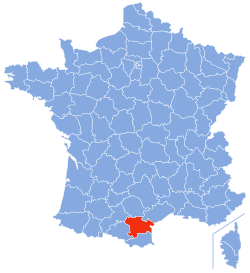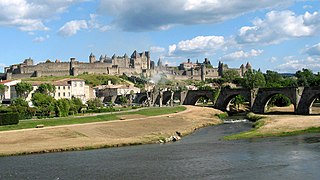Aude
Aude | |
|---|---|
 Location of Aude in France | |
| Coordinates: 43°5′N 2°25′E / 43.083°N 2.417°E | |
| Country | France |
| Region | Occitanie |
| Prefecture | Carcassonne |
| Subprefectures | Limoux, Narbonne |
| Government | |
| • President | André Viola |
| Area | |
| • Total | 6,139 km2 (2,370 sq mi) |
| Population (2014)[3] | |
| • Total | 365,478 |
| • Rank | 66th |
| • Density | 60/km2 (150/sq mi) |
| Demonym(s) | Audois, Audoises |
| Time zone | UTC+1 (CET) |
| • Summer (DST) | UTC+2 (CEST) |
| ISO 3166 code | FR-11 |
| Arrondissements | 3 |
| Cantons | 19 |
| Communes | 436 |
| Website | http://www.aude.fr/ |
Aude is a department in the region of Occitanie in southern France. It is named after the Aude river.
The inhabitants of the Aude are known, in French, as Audois (women: Audoises).[4]
History[change | change source]
Aude was created in 1790 during the French Revolution, when the whole of France was divided into departments, replacing the old provinces. Aude was formed with part of the old province of Languedoc.
It was divided in six districts: Castelnaudary, Carcassonne, Narbonne, Lagrasse, Limoux and Quillan, with Carcassonne as is capital.[5]
In 1800, with the creation of the arrondissements in France, the six districts were changed into four arrondissements: Carcassonne, Castelnaudary, Limoux and Narbonne. On 10 September 1926, the arrondissement of Castelnaudary was eliminated.[5]
Early forms of habitation[change | change source]
A skull was found, and named Homme de Tautavel (Tautavel Man). It was found in a cave on the site called Caune de l'Arago, near Tautavel. The fossils are between 300.000 and 450.000 years old. There are over 80 fragments; the skull belonged to a man in his twenties. He was about 1.65 m, and weighed around 45–55 kg. Other remains are two mandibles, belonging to a woman in her fifties, and to a man, about 20 to 25 years old. It looks like they did not know how to use fire yet. It also looks like they might have been cannibals, or that they preferred to scavenge for food, rather than hunt. Some bones of rhinoceros, horses, wild sheep (called Mouflon), Tahrs (resemble wild goats), Muskox (a type of bovine), deer, and reindeer were found in the cave. There is an ongoing debate if this hominian is directly related to the Neanderthal. If they are not they would be Homines erecti (currently they are classified as H. erectus Tautavelensis). If they are direct predecessors of the Neanderthals, they would be Homo heidelbergensis.
Geography[change | change source]
Aude has an area of 6,139 km2 (2,370 sq mi).[2] It is surrounded by the departments of Pyrénées-Orientales, Ariège, Haute-Garonne, Tarn, and Hérault, with the Gulf of Lion (Mediterranean Sea) on the east.
The main river in the department is the Aude river which gives its name to the department. Other important rivers are Fresquel and Orbieu; these two rivers are tributaries of the Aude river.
The highest point in the department is the Pic de Madrès (42°39′7″N 2°11′32″E / 42.65194°N 2.19222°E), in the French Pyrenees; it is 2,469 m (8,100 ft) high.[6]
Administration[change | change source]
The département is managed by the Departamental Council of Aude in Carcassonne. Aude is part of the region of Occitanie.
Administrative divisions[change | change source]
There are 3 arrondissements (districts), 19 cantons and 436 communes (municipalities) in Aude.
| INSEE code |
Arrondissement | Capital | Population[7] (2014) |
Area[8] (km²) |
Density (Inh./km²) |
Communes |
|---|---|---|---|---|---|---|
| 111 | Carcassonne | Carcassonne | 161,442 | 2,668.1 | 60.5 | 207 |
| 112 | Limoux | Limoux | 44,467 | 1,780.9 | 25.0 | 147 |
| 113 | Narbonne | Narbonne | 159,569 | 1,690.0 | 94.4 | 82 |
The following is a list of the 19 cantons of the Aude department (with their INSEE codes),[7] following the French canton reorganisation which came into effect in March 2015:[9]
- La Piège au Razès (1101)
- Carcassonne-1 (1102)
- Carcassonne-2 (1103)
- Carcassonne-3 (1104)
- Le Bassin chaurien (1105)
- Les Basses Plaines de l'Aude (1106)
- Les Corbières (1107)
- Le Lézignanais (1108)
- La Région Limouxine (1109)
- La Malpère à la Montagne Noire (1110)
- Narbonne-1 (1111)
- Narbonne-2 (1112)
- Narbonne-3 (1113)
- La Haute-Vallée de l'Aude (1114)
- Le Haut-Minervois (1115)
- Le Sud-Minervois (1116)
- Les Corbières maritimes (1117)
- La Montagne d'Alaric (1118)
- La Vallée de l'Orbiel (1119)
Demographics[change | change source]
The Aude department has a population, in 2014, of 365,478,[3] for a population density of 59.5 inhabitants/km2. The arrondissement of Carcassonne, with 161,442 inhabitants, is by far the largest. The other two arrondissements, Limoux and Narbonne, have respectively 44,467 and 159,569 inhabitants.[7]
Evolution of the population in Aude

The main cities in the department are:
| City | Population (2014)[7] |
Arrondissement |
|---|---|---|
| Narbonne | 52,855 | Narbonne |
| Carcassonne | 45,941 | Carcassonne |
| Lézignan-Corbières | 11,248 | Narbonne |
| Castelnaudary | 11,096 | Carcassonne |
| Limoux | 10,275 | Limoux |
| Coursan | 5,916 | Narbonne |
| Port-la-Nouvelle | 5,635 | Narbonne |
| Sigean | 5,473 | Narbonne |
| Trèbes | 5,498 | Carcassonne |
Gallery[change | change source]
Related pages[change | change source]
References[change | change source]
- ↑ "Les élus du Conseil départemental de l'Aude" (in French). Département de l'Aude. Retrieved 7 January 2017.
- ↑ 2.0 2.1 "Comparateur de territoire Département de l'Aude (11)". Publications et statistiques pour la France ou les régions (in French). Institut national de la statistique et des études économiques - INSEE. Retrieved 7 January 2017.
- ↑ 3.0 3.1 "Populations légales 2014 des départements et des collectivités d'outre-mer" (in French). Institut national de la statistique et des études économiques - INSEE. Retrieved 7 January 2017.
- ↑ "Aude (11)" (in French). habitants.fr. Retrieved 10 July 2015.
- ↑ 5.0 5.1 "Historique de l'Aude". Le SPLAF (in French). Retrieved 10 July 2015.
- ↑ "Pic de Madrès, France". Retrieved 7 January 2017.
- ↑ 7.0 7.1 7.2 7.3 "Régions, départements, arrondissements, cantons et communes" (PDF). Populations légales 2014 (in French). Institut national de la statistique et des études économiques - INSEE. Retrieved 7 January 2017.
- ↑ "Département de l'Aude (11) et Arrondissements". Comparateur de territoire (in French). Institut national de la statistique et des études économiques - INSEE. Retrieved 7 January 2017.
- ↑ "Décret n° 2014-204 du 21 février 2014 portant délimitation des cantons dans le département de l'Aude" (in French). Légifrance.gouv.fr. Retrieved 10 July 2015.
Other websites[change | change source]
- General council website (in French)
- Prefecture website Archived 2007-03-10 at the Wayback Machine (in French)
- Aude official tourism website Archived 2010-11-03 at the Wayback Machine
- Photos of the Aude Department (in French)






